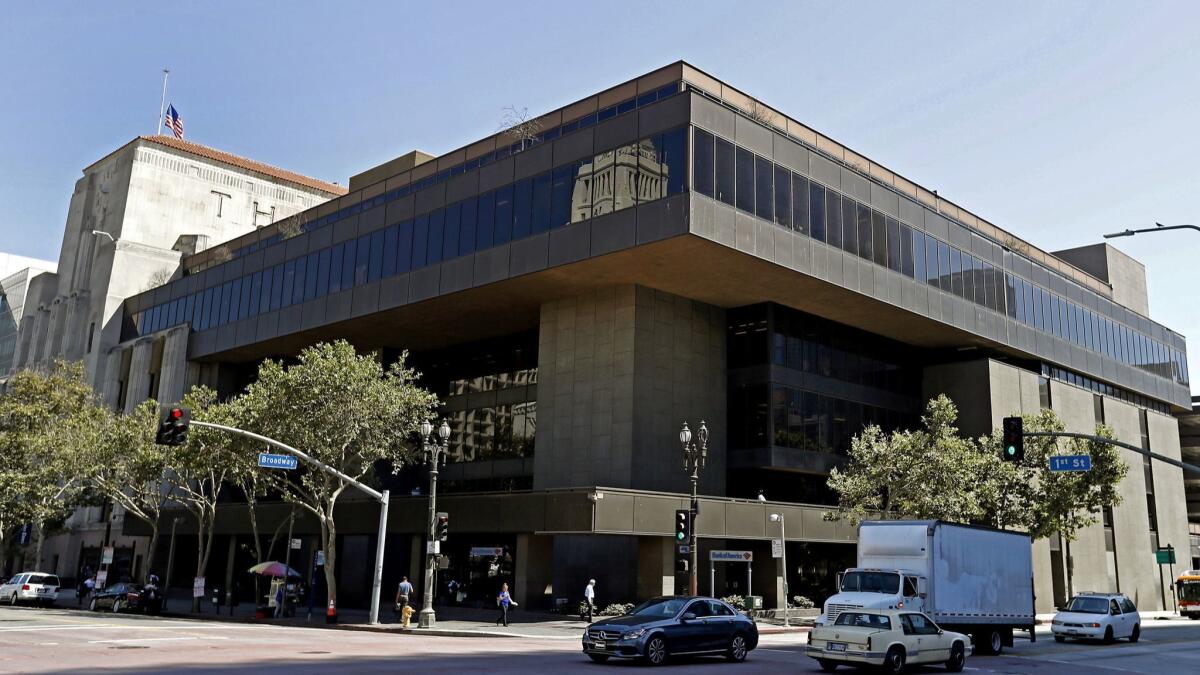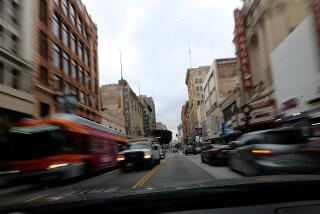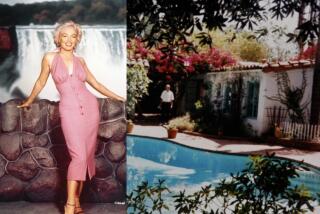City commission will consider bid to declare Los Angeles Times buildings historic-cultural monuments

A bid to gain protected status for three Los Angeles Times buildings moved forward Thursday when the Cultural Heritage Commission agreed to consider an application to make them historic-cultural monuments.
Monument status could hinder a plan to redevelop the downtown L.A. block where they stand. The property is owned by Onni Group, which purchased the former Times Mirror Square in 2016 with plans to redevelop it.
The Times, now a tenant of Onni in its historic home, is nearly finished moving to El Segundo, where it will occupy a building owned by Dr. Patrick Soon-Shiong, the new owner of The Times.
Onni’s proposal calls for retaining the oldest of the structures — two Art Deco-style buildings that were constructed on the east side of the block along Spring Street in the 1930s and 1940s and include The Times’ newsroom. The upper-floor offices would be refurbished, with the ground floors converted to restaurants, shops and a grocery store.
The three structures on the western half — a parking garage, former printing plant and a modern office building — would be demolished to make way for two apartment towers of 37 and 53 stories containing more than 1,100 apartments, a swimming pool and other luxury amenities, as well as ground-floor shops.
The focus of the preservation campaign is the Times Mirror Building, offices completed in 1973 and designed by William Pereira, the architect of the Transamerica Pyramid in San Francisco, CBS Television City in the Fairfax district and the futuristic Theme Building in the heart of Los Angeles International Airport.
If the Times buildings are declared city monuments, the Cultural Heritage Commission can block demolition for as long as six months with a majority vote of its members. The City Council can extend the ban for another six months.
Delays would give the city time to consider alternate uses for the buildings or to encourage developers to keep parts of historic structures, such as their facades, intact.
Demolition could occur after that if the development is otherwise approved by the city. Onni would also have to prepare an environmental impact report on the project.
City officials are at odds with Soon-Shiong over his announced desire to remove all Times property from the buildings, including historic items in the famous Globe Lobby entrance on First Street. He has said he plans to create a Times museum in El Segundo.
Last weekend, workers representing The Times’ owner removed busts of the newspaper’s first four publishers and an eagle statue that has stood atop three different Times buildings dating back to the early 20th century.
Los Angeles preservationist and cultural historian Richard Schave, who is spearheading the monument campaign, told the commission Thursday that The Times should return those items.
“They are identified as historic contributing features of the application,” he said.
Don Spivack, a former administrator of the city’s Community Redevelopment Agency and supporter of the campaign, said in an interview that the items have been in the lobby for several decades and that “most observers would consider that material to be part of the fabric of that space.”
City officials earlier this week called on The Times not to carry off the 5½ -foot aluminum globe, which is the lobby’s centerpiece, or to remove a dome-shaped mural overhead painted by artist Hugo Ballin in 1935 that depicts the process of putting out a newspaper at the time.
Onni Chief of Staff Duncan Wlodarczak said the building sale agreement gave The Times permission to take “removable” items in the lobby.
The globe, however, “is the property of Onni and will remain in the lobby.”
A lawyer for the newspaper’s owner disagreed, telling the city Office of Historic Resources in a Tuesday letter obtained by The Times that the newspaper would honor the city’s request not to remove the globe now but asserted that it is the personal property of the newspaper.
“The Times reserves the right to remove the globe in the future,” attorney George J. Mihlsten wrote, but “will not remove it without further discussions” with Principal City Planner Ken Bernstein or the Cultural Heritage Commission.
The Times “has no intention to remove the murals,” he added.
Speaking for the Planning Department, spokesman Yeghig Keshishian said that the globe and murals “are significant historic features of the building and cannot be taken or altered without the proper city approvals.”
The commission’s unanimous vote Thursday to consider the application is the first step in the monument-approval process.
Members of the commission will tour Times buildings and hold another hearing to decide whether to recommend the application to the city’s Planning & Land Use Management Committee. If the committee supports it, the application will move to the City Council for a final decision. The process could take months.
Most speakers who came forward at Thursday’s meeting, including former Times Managing Editor Leo Wolinsky and Pereira’s daughter Monica Pereira, voiced support for the application.
“The Times Mirror Building tells the story of an evolving city,” she said.
Miki Jackson of the Coalition to Preserve L.A. said the Times buildings “were where the history of Los Angeles was recorded.”
“In a world where everything is digital,” she said, “I hope we get to preserve something that is physical.”
An attorney representing Onni, Bill Delvac, was present but did not speak publicly. Onni is focused now on the city approval process for its proposed development, he told The Times later.
Josh Albrektson, a former member of the Downtown L.A. Neighborhood Council, said that Onni’s proposal would preserve the two older buildings and improve them, but that the 1973 Pereira building “absolutely destroys the look of the Art Deco building everyone loves” and shouldn’t be included in the monument application.
Twitter: @rogervincent
More to Read
Inside the business of entertainment
The Wide Shot brings you news, analysis and insights on everything from streaming wars to production — and what it all means for the future.
You may occasionally receive promotional content from the Los Angeles Times.











